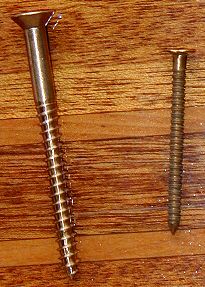 Our plans are all in "Imperial" measurements; they are not available in metric measurements. Our plans are not generated by a CAD program and are hand-drawn. It is not possible to simply push a button to change the measurements.
Our plans are all in "Imperial" measurements; they are not available in metric measurements. Our plans are not generated by a CAD program and are hand-drawn. It is not possible to simply push a button to change the measurements.
Screws: Should be "full body" (as shown in the photo, screw is on the left, boat nail is on the right). "Sheet metal screws" are not recommended. Count: We list screws by the gross (144) and dozen (12).
Boat Nails:These nails are "ring-shank, annular thread, silicon bronze". The larger the "wire" size, the smaller the diameter. i.e. a 3/4" #14 is smaller in diameter than a 3/4" #12. Nails are much cheaper to use than screws. They are most often used for fastening flat pieces together; pieces not under tension. They can, however, be used for most construction applications. When fastening longitudinals or planking to frames, screws are usually a better choice as they pull pieces together. Pounding nails into hardwoods such as oak, may require pilot holes. Nails are listed by the pound.
| Approximate count per pound of boat nails: |
|
| 3/4" #14 | 705 |
| 1" #12 | 305 |
| 1 1/4" #12 | 250 |
| 1 1/2" #12 | 205 |
| 1 3/4" #10 | 120 |
| 2" #10 | 105 |
Table: Millimeter equivalents of screw and
nail gauges specified in Glen-L plans
[inches (decimal) X 25.4 = mm]
| Gauge No. | Screw Diameter | Nail Diameter | ||
|---|---|---|---|---|
| inches | mm | inches | mm | |
| 8 | .163 | 4.1 | - | - |
| 10 | .189 | 4.8 | .134 | 3.4 |
| 12 | .216 | 5.5 | .109 | 2.8 |
| 14 | .242 | 6.2 | .083 | 2.1 |
| 18 | .294 | 7.5 | - | - |
Other conversion tables can be found in the Suppliers & Links section of our website.
Lumber sizes
One board foot - A lumber measurement. One board foot = 1" X 12" X 12". A piece of lumber 2" X 12" X 12" = 2 board feet. When width and thickness are specified, lumber may be called out as linear feet, i.e. 1" X 6" X 24 linear feet (lin. ft.). Linear feet is used when the the lumber will be cut into various lengths, as opposed to a piece 1" X 6" x 24' which would be a single piece of wood.
Lumber sizes: Width = actual, thickness = nominal
2x4, 2x6, 2x8: Certain pieces of lumber, most often used for setup members or motor stingers are nominal in width and thickness. i.e. A 2x4 is 1 1/2" x 3 1/2", 2x6 = 1 1/2" x 5 1/2", 2x8 = 1 1/2" x 7 1/2".
Why is this so? "Tradition" The nominal size is before milling. Actually, today, it is just a way to get more lumber out of a tree. If you want to use full width material, this is OK, but may require some minor adjustments.
Plywood lengths can always be standard lengths. If long sheets are called out, substitute shorter sheets and join with butt block or scarf joints.